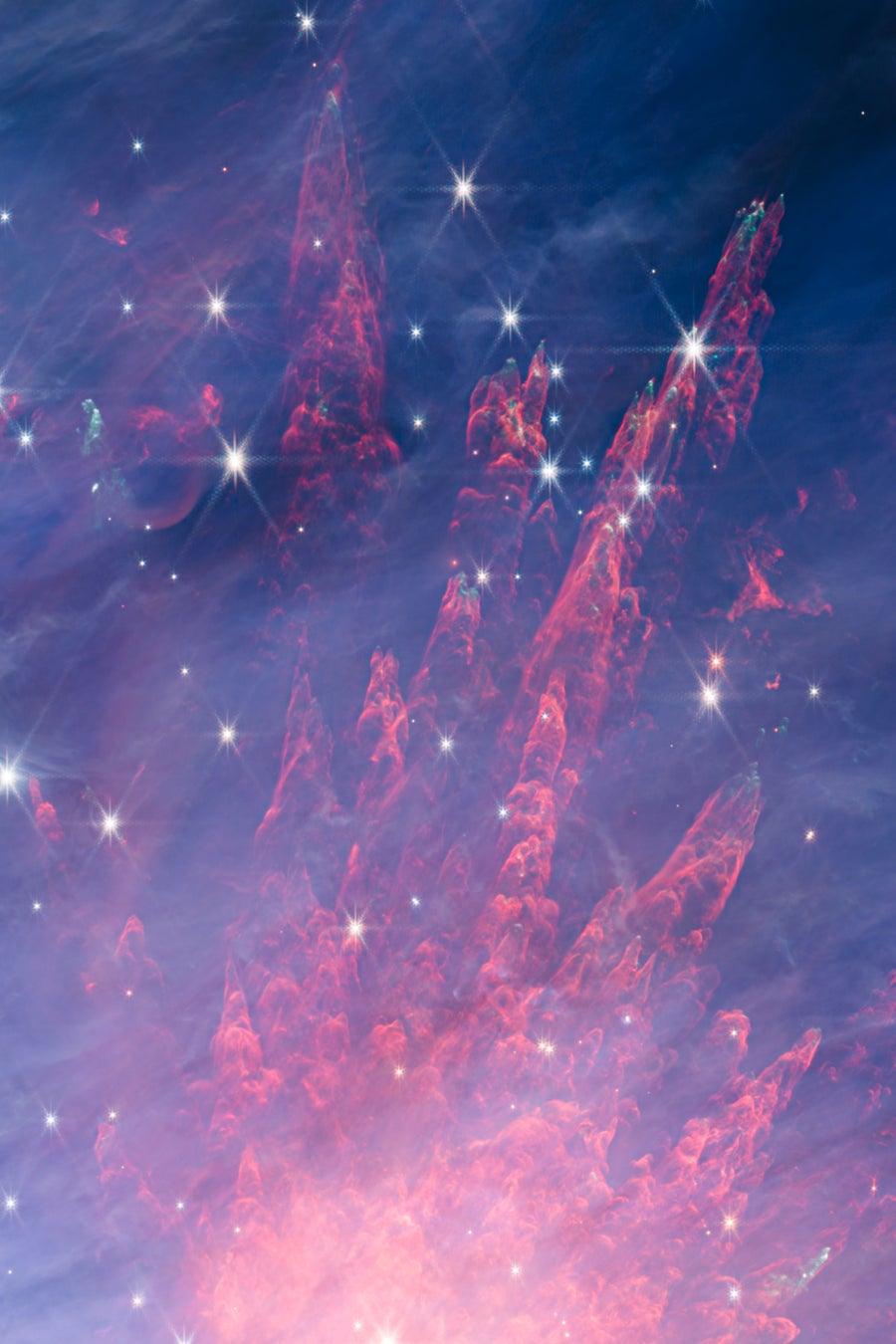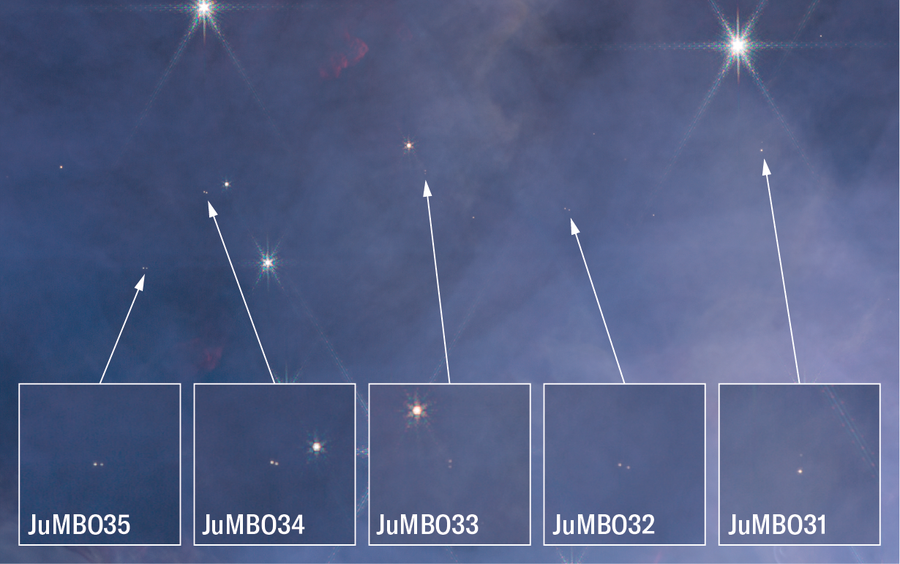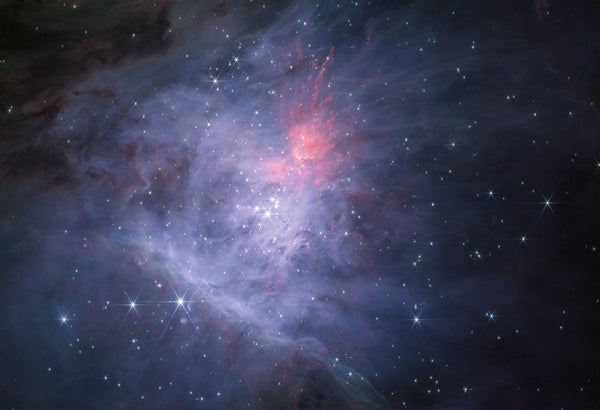Ah, the familiar chill in the air as autumn arrives, a reminder of turning leaves, the coming winter and—of course!—the return of the constellation Orion to the night sky, along with the constellation’s myriad astronomical wonders.
The best known of the latter is the iconic Orion nebula, a gas cloud so huge and bright that it’s visible to the naked eye despite being about 1,300 light-years from Earth. It’s the middle “star” in Orion’s dagger (the three stars dangling below the constellation’s belt). Even when viewed using binoculars, the nebula appears to be fuzzy, but with a small telescope its true nature starts to shine through: the Orion nebula isn’t merely a gas cloud; it’s also an immense stellar nursery, more than two dozen light-years across, where stars are being born.
Of course, when you study the Orion nebula with a 6.5-meter-wide space telescope tuned to infrared light, your view becomes exponentially better. This is just what astronomers did using the James Webb Space Telescope (JWST), and the resulting vistas are an incredible delight for the eyes and brain. Observing in the near-infrared spectrum (wavelengths of light that are a bit longer than our eyes can detect), JWST revealed hundreds of newborn stars. (“Newborn” means these stars began fusing hydrogen in their core just a few hundred thousand years ago—which, to astronomers, is practically yesterday.)
On supporting science journalism
If you're enjoying this article, consider supporting our award-winning journalism by subscribing. By purchasing a subscription you are helping to ensure the future of impactful stories about the discoveries and ideas shaping our world today.
Dominating the center of the JWST image above are the four stars of the Trapezium, the brightest stars in this cosmically young cluster. The brightest of these four, Theta1 Orionis C, is hundreds of thousands of times more energetic than the sun. Theta1 Orionis C shines so fiercely that it alone is responsible for most of the nebula’s glow. The image shows streamers and wisps of gas strewn across the Orion nebula and energized by the star’s radiance.
A burst of reddish gas can be seen as well. This gas, called Orion Molecular Cloud 1 (OMC1), looks like a fireworks explosion. In a sense, it is: it’s likely several suns’ worth of material blasting away from the site of a stellar catastrophe in which three massive stars collided and merged. This event unfolded with so much power that gas erupted away from it at speeds up to half a million kilometers per hour.
A second image of the same region, taken at substantially longer infrared wavelengths, is dominated by colder gas and cosmic dust. Stars don’t radiate much at these wavelengths and so appear much fainter.

The celestial fireworks of Orion Molecular Cloud 1, as seen in an infrared view from JWST. Credit: NASA/ESA/CSA; M. McCaughrean/S. Pearson (science leads and image processing) (CC BY-SA 3.0 IGO)
The real reason JWST turned its gaze to the Orion nebula wasn’t to take some pretty pictures, though. In the telescope’s view, there’s something more subtle but no less staggering lurking, too, which can best be introduced via a slight sky-watching digression.
You see, the onset of autumn and the approach of winter bring more than just Orion. On November 3 Jupiter will reach opposition, meaning it will be opposite the sun in the sky and rise when the sun sets. Jupiter will be closest to Earth then: from our view, it will remain up all night and will appear at its brightest and biggest. In the coming year, this will be the best time to see the planet: its four huge Galilean moons will be easily spotted in binoculars, and the banded storms striping its face will be visible in small telescopes.
What, you’re wondering, does Jupiter have to do with JWST and Orion? The answer is that we’re not exactly sure how Jupiter formed, and the Orion nebula’s stellar nursery nurtures not only stars but also newborn planets, which are amenable to JWST’s prying infrared eye. Much of what we do know about stellar and planetary births alike comes from observing big, bright stars whose luminosity is equal to or greater than that of the sun. We don’t have much data on the formation of less massive stars, ones so dim that they fade to naked-eye invisibility even when they’re quite close to Earth.
JWST, however, can spot such objects easily in the Orion nebula. Even better, planetary-mass objects are hot when they’re born, cooling slowly over millions of years. That means any in the Orion Nebula will glow in infrared wavelengths, revealing to JWST not only their presence but also important details such as their temperature and mass.
That’s why these images were taken, to learn more about cosmic origins by studying the otherwise hidden distribution of small stars (and big planets) lurking in the Orion nebula’s vast brood. To their delight and amazement, the astronomers who proposed and performed these JWST observations of Orion found more than 500 objects there that may be planetary-mass. (That means “less than about a dozen times Jupiter’s mass.” Anything more massive than that is what we call a brown dwarf, an object whose mass is intermediate between that of planets and stars.) And surprisingly, these objects are free-floating, adrift in space and unattached to any star.
This may at first appear deceptively simple. After all, we already know that in the galaxy, high-mass stars are rare, while low-mass stars are abundant. It’s like hitting a rock with a hammer: in the debris, you get one or two big chunks, more intermediate-sized fragments and lots of tiny shards. The comparison of course is imperfect—astrophysics isn’t backyard geology, and giant gas clouds aren’t rocks! Knowing more about where and how this analogy breaks down would be useful. In particular, researchers have long wondered whether there might be some cutoff at the lower end of structure formation in stellar nurseries where the physics dictates that extremely low-mass objects such as planets won’t arise.
The newobservations have yet to receive formal, peer-reviewed publication. Nevertheless, they convincingly suggest that no low-end bottleneck exists. Finding so many planetary-mass objects means nature is quite capable of creating them. But how did they form, exactly?

This zoomed-in image of JWST’s infrared view of a portion of the Orion nebula reveals several Jupiter-mass binary objects, or JuMBOs (insets). Adrift far from any star and still aglow with the heat from their cosmic births, these bizarre planetary pairs exist in defiance of theorists’ expectations. Credit: Mark McCaughrean/Sam Pearson/NASA/ESA/CSA
Many of Orion’s free-floating planetary objects spied by JWST are close enough together that they are likely orbiting each other in wide binary systems. In fact, the researchers who discovered these things call them Jupiter-Mass Binary Objects (JuMBOs). How they arose is difficult to understand. We know that such planetary objects form around stars. And we also know that in the chaotic early days of a planetary system, close encounters between worlds can eject one or more of them, dooming the outcasts to wander through space like interstellar nomads. Although many such rogue planets have been discovered, it’s not at all clear how they could form a binary system.
Yet 40 of the planetary-mass objects seen in the images—nearly 10 percent of them—are in binaries.
It’s possible they were born like stars, arising directly from the gas in the Orion nebula, but that would be weird, too. Although binary stars are common, there are far more of these JuMBOs seen than expected, given previous observations of how planetary-mass objects form. Is there some new mechanism that kicks in at low masses that promotes Jupiter-class objects popping up in wide binary systems?
Astronomers don’t know—yet. Further observations could help clear this up.
Not knowing the answer is a little frustrating, but who doesn’t love a mystery—especially one of such cosmic proportions? And it’s a great reminder that the sky is full of such puzzles, even among the most well-studied and lovely objects we know.
If you find yourself out on a clear night this winter, hunt out Orion and take a look at that middle “star” of the three below the constellation’s belt. Just because you can see it doesn’t mean you can see it. There’s still a lot left to uncover there.
